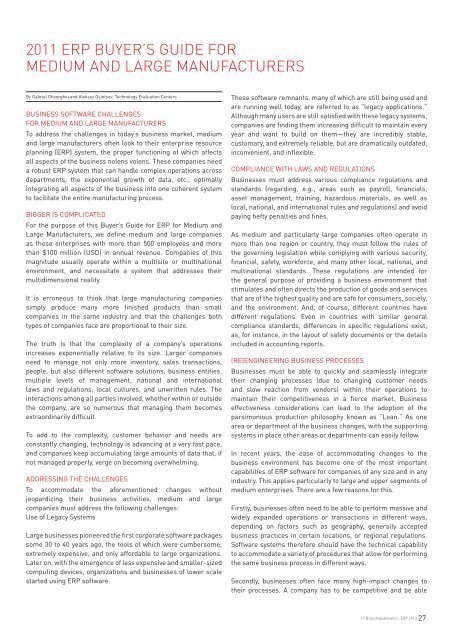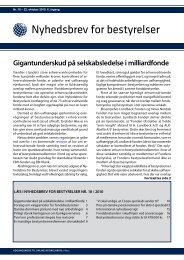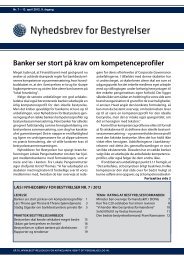IT-Branchepublikation: ERP - Nyhedsbrev for Bestyrelser
IT-Branchepublikation: ERP - Nyhedsbrev for Bestyrelser
IT-Branchepublikation: ERP - Nyhedsbrev for Bestyrelser
Create successful ePaper yourself
Turn your PDF publications into a flip-book with our unique Google optimized e-Paper software.
2011 <strong>ERP</strong> BUyER’S gUIdE FOR<br />
MEdIUM aNd LaRgE MaNUFaCTURERS<br />
by Gabriel Gheorghiu and Aleksey Osintsev, Technology Evaluation Centers<br />
bUSINESS SOFTwArE ChALLENGES<br />
FOr MEDIUM AND LArGE MANUFACTUrErS<br />
To address the challenges in today’s business market, medium<br />
and large manufacturers often look to their enterprise resource<br />
planning (ErP) system, the proper functioning of which affects<br />
all aspects of the business nolens volens. These companies need<br />
a robust ErP system that can handle complex operations across<br />
departments, the exponential growth of data, etc., optimally<br />
integrating all aspects of the business into one coherent system<br />
to facilitate the entire manufacturing process.<br />
bIGGEr IS COMPLICATED<br />
For the purpose of this buyer’s Guide <strong>for</strong> ErP <strong>for</strong> Medium and<br />
Large Manufacturers, we define medium and large companies<br />
as those enterprises with more than 500 employees and more<br />
than $100 million (USD) in annual revenue. Companies of this<br />
magnitude usually operate within a multisite or multinational<br />
environment, and necessitate a system that addresses their<br />
multidimensional reality.<br />
It is erroneous to think that large manufacturing companies<br />
simply produce many more finished products than small<br />
companies in the same industry and that the challenges both<br />
types of companies face are proportional to their size.<br />
The truth is that the complexity of a company’s operations<br />
increases exponentially relative to its size. Larger companies<br />
need to manage not only more inventory, sales transactions,<br />
people, but also different software solutions, business entities,<br />
multiple levels of management, national and international<br />
laws and regulations, local cultures, and unwritten rules. The<br />
interactions among all parties involved, whether within or outside<br />
the company, are so numerous that managing them becomes<br />
extraordinarily difficult.<br />
To add to the complexity, customer behavior and needs are<br />
constantly changing, technology is advancing at a very fast pace,<br />
and companies keep accumulating large amounts of data that, if<br />
not managed properly, verge on becoming overwhelming.<br />
ADDrESSING ThE ChALLENGES<br />
To accommodate the a<strong>for</strong>ementioned changes without<br />
jeopardizing their business activities, medium and large<br />
companies must address the following challenges:<br />
Use of Legacy Systems<br />
Large businesses pioneered the first corporate software packages<br />
some 30 to 40 years ago, the tools of which were cumbersome,<br />
extremely expensive, and only af<strong>for</strong>dable to large organizations.<br />
Later on, with the emergence of less expensive and smaller-sized<br />
computing devices, organizations and businesses of lower scale<br />
started using ErP software.<br />
These software remnants, many of which are still being used and<br />
are running well today, are referred to as “legacy applications.”<br />
Although many users are still satisfied with these legacy systems,<br />
companies are finding them increasing difficult to maintain every<br />
year and want to build on them—they are incredibly stable,<br />
customary, and extremely reliable, but are dramatically outdated,<br />
inconvenient, and inflexible.<br />
COMPLIANCE w<strong>IT</strong>h LAwS AND rEGULATIONS<br />
businesses must address various compliance regulations and<br />
standards (regarding, e.g., areas such as payroll, financials,<br />
asset management, training, hazardous materials, as well as<br />
local, national, and international rules and regulations) and avoid<br />
paying hefty penalties and fines.<br />
As medium and particularly large companies often operate in<br />
more than one region or country, they must follow the rules of<br />
the governing legislation while complying with various security,<br />
financial, safety, work<strong>for</strong>ce, and many other local, national, and<br />
multinational standards. These regulations are intended <strong>for</strong><br />
the general purpose of providing a business environment that<br />
stimulates and often directs the production of goods and services<br />
that are of the highest quality and are safe <strong>for</strong> consumers, society,<br />
and the environment. And, of course, different countries have<br />
different regulations. Even in countries with similar general<br />
compliance standards, differences in specific regulations exist,<br />
as, <strong>for</strong> instance, in the layout of safety documents or the details<br />
included in accounting reports.<br />
(rE)ENGINEErING bUSINESS PrOCESSES<br />
businesses must be able to quickly and seamlessly integrate<br />
their changing processes (due to changing customer needs<br />
and slow reaction from vendors) within their operations to<br />
maintain their competitiveness in a fierce market. business<br />
effectiveness considerations can lead to the adoption of the<br />
parsimonious production philosophy known as “Lean.” As one<br />
area or department of the business changes, with the supporting<br />
systems in place other areas or departments can easily follow.<br />
In recent years, the ease of accommodating changes to the<br />
business environment has become one of the most important<br />
capabilities of ErP software <strong>for</strong> companies of any size and in any<br />
industry. This applies particularly to large and upper segments of<br />
medium enterprises. There are a few reasons <strong>for</strong> this.<br />
Firstly, businesses often need to be able to per<strong>for</strong>m massive and<br />
widely expanded operations or transactions in different ways,<br />
depending on factors such as geography, generally accepted<br />
business practices in certain locations, or regional regulations.<br />
Software systems there<strong>for</strong>e should have the technical capability<br />
to accommodate a variety of procedures that allow <strong>for</strong> per<strong>for</strong>ming<br />
the same business process in different ways.<br />
Secondly, businesses often face many high-impact changes to<br />
their processes. A company has to be competitive and be able<br />
<strong>IT</strong>-<strong>Branchepublikation</strong>: <strong>ERP</strong> 2013<br />
27






